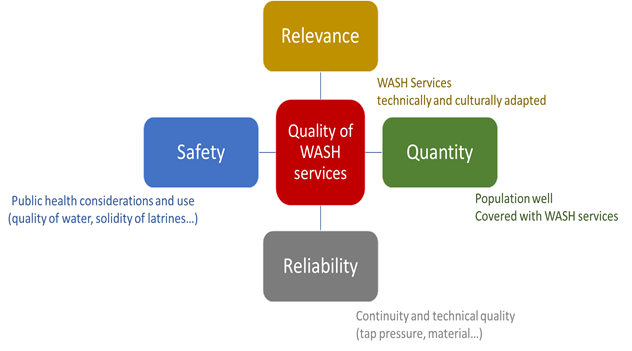Technical aspects
Monitor technical aspects of the WASH services delivered to beneficiaries
The quality of WASH services that are provided to the affected population must meet minimum standards agreed among partners. These standards are based on national standards, international standards, or contextualized depending on the context and the emergency phase. Technical standards to be applied for the response must have been agreed by partners and described in the Standards & Methodologies chapter of the WASH Cluster Strategic Operational Framework. The technical quality of the WASH services embraces four main areas: relevance, quantity, reliability and safety (see figure hereunder); One of the main source of technical quality indicators is the Sphere handbook.
The monitoring of the WASH service quality must be routinely done by the partner themselves for their program. It is recommended that partners report the results of their quality monitoring system to the WASH coordination platform, provided that this is stipulated in the agreed quality assurance system.
Depending on the agreed modalities, field-based monitoring of partners' activities can be:
- done by third parties, such as the government or a private company
- reported directly by the beneficiaries to an independent company or organization, through a feedback and complaints mechanism
- monitored through field visit by the WASH coordination team at subnationnal level etc.
A usual quality monitoring tool is the WASH Infrastructure "Spot-check", in which latrines or water points are being physically monitored using a standard check list.
Integration of key WASH quality indicators into other monitoring systems (ex: The National Health Interview Survey (NHIS), Displacement tracking Matrix (DTM) etc.), and engagement with other key clusters, can also help to flag WASH quality issues.
